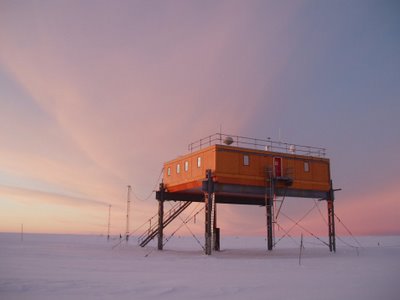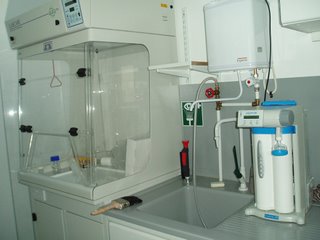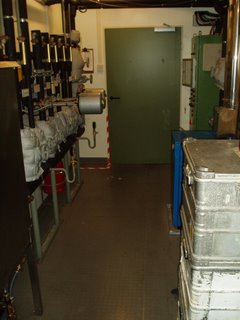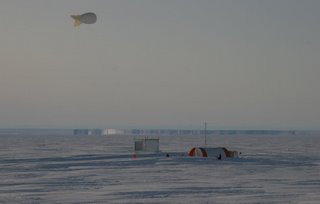Tour of The Simpson
The Ice and Climate Building is otherwise known as The Simpson Platform. It was named after Sir George Clarke Simpson who was a meteorologist with Scott (1910-1913) and later the Director of the Met Office (1920-1938).
 The Simpson Platform looking North with the two Met Masts on the left.
The Simpson Platform looking North with the two Met Masts on the left.This platform has four jackable legs, one set of stairs and a ladder at the back.
On the roof are various domes and antennas which we use to collect a variety of data.
A Tour of The Simpson
As you come up the wobbly metal staircase you reach the small open platform. This has a wooden floor which we sweep regularly so the snow doesn't build up too much. On the platform we store a large collection of metal poles (you never know when they might be useful), a spare dome for tracking the balloon, unused air sampling flasks (MAKS), a few empty boxes (got to be careful they don't blow away), spare balloon dipping mix in a jerry can and a few other odds and ends. Also on the platform is the crane (which we tend to only use during relief), and an fuel tank which will be used to heat the Simpson during it's decommissioning.
The Simpson gets it's power and heat via a tunnel in the ice (30m) which links to the Laws Platform (main platform). Each of the platforms have a wooden horsebox which can be used to acess the tunnels. We also have ladder access to the roof from the platform.
Going through the door you'll see a corridor with the fire exit at the other end (11.5metres away). In the corridor are some quick Met equipment, Safety equipment and our jackets, boots etc.
If you were to turn right straight away you'd get to the Ozone Lab- so called cause this is where we keep the Dobson Ozone Spectrophotometer (or the Dobson for short). This is the instrument that discovered the hole in the ozone layer. Because the instruments (this one and the one at Faraday) are on the ground (ie. not on a satellite), the metbabes of old were able to do extra checks on the instruments to check that the readings they were getting weren't erroneous. It turns out that the instruments were fine and there was indeed an ozone hole appearing over Antarctica during every spring which then closes up before the summer. This is still happening and you can see this season's ozone measurements using this link.
We also have a few other projects based in this small room. The first is turbidity. We get a few measurements done a year on very clear days during the summer. It measures stuff in the atmosphere that isn't water based, like volcanic dust.
The second is snow sampling. We dig a bucket of snow every week and wait for it to melt. Then we decant it into various bottles and send them to places around the world (NOAA) for them to have a good 'clean base level' of precipitation.
Then there's MAKS which is air sampling. We don't do it inside but keep the flasks in this room and recharge the battery. This is the same deal as the snow, the air is assumed to be the cleanest in the world- so when they start to measure (and they do) increased levels of Methane and Carbon dioxide then...., well try and use the car less.
A little further down the corridor is the Met Office. This is where the three of us (and a few more in the summer time) sit and do work on the computer (like updating blogs). We also famously have a hammock (not in photo) which is primarily used by visitors while they sip on their lovely cups of tea.
 The Met Office: We have 5 PC workspaces and a wee tea area.
The Met Office: We have 5 PC workspaces and a wee tea area.The last room on the right of the corridor is the Met Lab. This is a large room with lots of PC's and equipment. We measure the stations lateral movement using a GPS logger, measure the amount of cloud, the present weather, a host of other meteorological data that we send back to the Met Office. We also set up and record the data from the daily weather balloon, and look at the day's satellite images tracked and received by our Dartcom satellite (this has been brought in for the winter since it's important that it's intact for the pilot's return and our strong winds keep on blowing it off the roof).
 The Met Lab 1: Most of our 'Met' loggers live here; Cloudbase recorder, Present Weather Detector, GPS position and the Milos Met Weather Station (we enter our observer met in here too).
The Met Lab 1: Most of our 'Met' loggers live here; Cloudbase recorder, Present Weather Detector, GPS position and the Milos Met Weather Station (we enter our observer met in here too). Met Lab 2: The weather balloon is in the far left corner and the HRPT satellite dome is to the very left. This room is also used by any wondering summer scientist who need a place to call home.
Met Lab 2: The weather balloon is in the far left corner and the HRPT satellite dome is to the very left. This room is also used by any wondering summer scientist who need a place to call home.The FOCAS Lab (or Space lab) is right across the corridor and is a small room used to house the boundary layer loggers. We also use it to set up the sondes (a sonde is a met instrument that can be attached to a weather balloon, blimp or kite) and we receive the data from any blimp flights we do. There's also a large fridge freezer in this room which we store the snow samples and air filters that we change in the CASLab.
 Focas Lab 1: There are a number of instruments around the base (and beyond) that we keep an eye on from these loggers.
Focas Lab 1: There are a number of instruments around the base (and beyond) that we keep an eye on from these loggers. Focas Lab 2: This equipment is part of the Focas and Cefac projects. We send these sondes up on our blimp around 400 metres. In the past these sondes have also been flown on stable kites. The spare sodar electronics box and speaker are under the desk.
Focas Lab 2: This equipment is part of the Focas and Cefac projects. We send these sondes up on our blimp around 400 metres. In the past these sondes have also been flown on stable kites. The spare sodar electronics box and speaker are under the desk.At the end of the Focas Lab is the Wet Chemistry Lab. This is a special lab which has a large oven, a laminar flow hood and an emergency shower. This is a lab where chemicals can be mixed, stored and disposed of cleanly. Every three years or so BAS try to send down an overwintering atmospheric chemist to do intensive short term studies of the air and snow.
 Wet Chem 1: The Wet Chemistry Lab is filled with all sorts of equipment. It only gets used intensively every three years when an overwintering chemist is here.
Wet Chem 1: The Wet Chemistry Lab is filled with all sorts of equipment. It only gets used intensively every three years when an overwintering chemist is here.This is where we prepare the ozone sonde for blimp flying.
 Wet Chem 2: The flow hood, sink, water distillation unit (and emergency shower pull cord in the distance).
Wet Chem 2: The flow hood, sink, water distillation unit (and emergency shower pull cord in the distance).North of these rooms is the Met Workshop. We have a lot of electronics gear as well as some basic mechanical tools (hammers, saws etc.). I tend to only saw things in here, or look for tools for things elsewhere, but Andy is the qualified electronic engineer this year and he's been spending a lot of time in here.
 The workshop: Well used and well loved - be it a bit messy.
The workshop: Well used and well loved - be it a bit messy.Next along this side is the storeroom. This is where we keep all of our spares for each experiment as well as enough balloons and sondes for a year or so, a lot of spare cables, mast equipment and ??** well, we're in the middle of going through it and we've already found a few gems.
 The storeroom. Andy's sorting out the cables today (that's why the room's a bit of a mess). This room is always full- no matter how much you take out or put in.
The storeroom. Andy's sorting out the cables today (that's why the room's a bit of a mess). This room is always full- no matter how much you take out or put in.The last two rooms aren't very interesting. One is the plant room where all of the services come in and are monitored. Brian the plumber does his daily checks here, we have a small meltank of our own water in this room and a lot of emergency medical equipment.
 The Plant Room: The meltank on the very left, emergency medical equipment on the very right, pipes with a lot of water going through them to warm the building on the far left, electricity, transformers and things on the far right.
The Plant Room: The meltank on the very left, emergency medical equipment on the very right, pipes with a lot of water going through them to warm the building on the far left, electricity, transformers and things on the far right.
At the end of this corridor is the toilet. We have a urinal (that I use with help from my trusty pee-funnel) and an incinerator toilet which burns the waste. Lovely.
I hope you've enjoyed the tour and your tea.
If you're actually in the area and would like a proper tour with a bit of science thrown in don't hesitate to drop in.
 The Plant Room: The meltank on the very left, emergency medical equipment on the very right, pipes with a lot of water going through them to warm the building on the far left, electricity, transformers and things on the far right.
The Plant Room: The meltank on the very left, emergency medical equipment on the very right, pipes with a lot of water going through them to warm the building on the far left, electricity, transformers and things on the far right.At the end of this corridor is the toilet. We have a urinal (that I use with help from my trusty pee-funnel) and an incinerator toilet which burns the waste. Lovely.
I hope you've enjoyed the tour and your tea.
If you're actually in the area and would like a proper tour with a bit of science thrown in don't hesitate to drop in.









